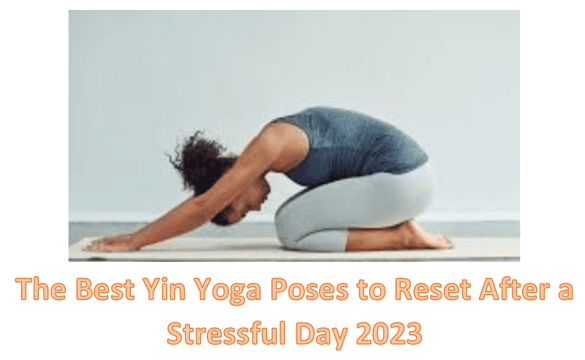The Best Yin Yoga Poses to Reset After a Stressful Day 2023 – As a person living in a modern, fast-paced, and comfortable lifestyle, we all face challenges and stress on a daily basis. Work, social life, and other commitments can cause us to feel more emotionally and physically exhausted. However, in order to overcome this stress, we must learn how to manage our emotions and improve our quality of life. The best way to accomplish this is to practice yin yoga.

What is Yin Yoga?
Yin Yoga is a type of yoga that emphasizes holding poses for longer periods of time than more active forms of yoga. This yoga is primarily concerned with relaxing muscles, strengthening connective tissue, and activating energy in the body. The movements in yin yoga are gentle and calm, helping us to release tension and go deeper within ourselves.
The Principles of Yin Yoga
Yoga Yin is based on several fundamental principles, including the use of gravity, otot relaxation, and more time spent in each position. During the course of the course, we are advised to stay relaxed and to give ourselves enough time to fully comprehend each concept. This helps us enjoy our conversations and reduce stress.
Benefits of Yin Yoga for Stress Relief
Yoga provides numerous benefits that are not well recognized in the treatment of stress. Among the many advantages are:
- Deep Relaxation: Long-held poses serve to relieve muscle tension and allow us to contemplate and relax.
- Calming the Nervous System: Slow movement and deep breathing boost the parasympathetic nerve system, which is in charge of soothing the body and mind.
- Reduces Cortisol: Yin yoga has been demonstrated to lower cortisol levels in the body, which can help relieve chronic stress.
- Increases Flexibility: Holding poses for prolonged periods of time improves flexibility and circulation in certain regions of the body.
- Increasing Self-Awareness: We are urged to ponder and connect with ourselves more fully in every movement.
After learning about the benefits of yoga for stress relief, we’ll look at some of the best positions for dealing with stress after a long day.
The Best Yin Yoga Poses for Stress Relief
- Child’s Pose (Balasana)
Child’s Pose is a very sweet position that opens up the shoulders and hips. We can use it as a starting point to focus on our daily activities and to energize our entire body. - Cat-Cow Stretch (Marjaryasana/Bitilasana)
Changing between the Cat and Cow Stretches helps to warm and bend the spine while also strengthening the back and abdominal muscles. - Forward Fold (Uttanasana)
This forward stretching stance relieves back strain and stimulates the adrenal glands, which are in charge of responding to stress. - Sphinx Pose (Salamba Bhujangasana)
Sphinx posture expands the chest and shoulders, relieving stress and strengthening the lower back. - Butterfly Pose (Baddha Konasana)
We open our hips and thighs in the Butterfly posture, which are often regions where we hold emotional strain. - Melting Heart Pose (Anahatasana)
This position opens the chest and stretches the shoulders, which relieves stress in the area. - Supine Twist (Supta Matsyendrasana)
This torsion exercise relaxes your back while opening your chest and shoulders. - Supported Bridge Pose (Setu Bandha Sarvangasana)
To help relax your lower back, you support your hips with a pillow or other item in this position. - Legs-Up-The-Wall Pose (Viparita Karani)
Placing your feet against a wall improves blood circulation and relieves fatigued legs. - Corpse Pose (Savasana)
Savasana is the final posture in yin yoga, in which we lie down completely relaxed to absorb the benefits of the preceding practice and to find inner serenity.
Practicing Yin Yoga Mindfully
It is essential to practice yin yoga consciously and calmly. Here are some pointers for sensible yin yoga practice:
- Create a Relaxing Environment: Select a peaceful and comfortable location for yin yoga practice, and add scented candles or relaxing music to create a relaxing ambiance.
- Concentrate on Breathing: During practice, concentrate on calm, deep breathing. Regular breathing exercises help to relax the nervous system and mind.
- Accept Calm: Allow yourself time in each position to ponder and accept your own calm.
- Be gentle and patient with yourself: Do not force yourself into excessive situations. Allow yourself to do it within the boundaries of your comfort.
Incorporating Yin Yoga into Your Daily Routine
Including yin yoga in your daily practice can help you reduce stress and improve your overall well-being. Here are some pointers to help you include yin yoga into your routine:
- Allow at least 15 to 30 minutes per day for yin yoga practice.
- Choose a Quiet, Uninterrupted period: Select a quiet, undisturbed period, such as the morning before beginning an activity or the evening before going to bed.
- You can combine yin yoga with other calming activities such as reading a book or listening to relaxing music.
Additional Tips for Stress Management
In addition to yin yoga, the following strategies can help you handle stress better:
- Mindfulness Meditation: Set aside some time each day to practice mindfulness meditation. This can help with stress management and attention.
- Journaling: Journaling is an efficient approach to express your ideas and feelings, which can aid in the reduction of emotional strain.
- Being in Nature: Spending time in nature might help you find inner serenity and tranquillity.
- Limit Screen Time: Avoid spending too much time in front of a screen, especially before going to bed.
- Prioritize Adequate Sleep: Ensure that you get enough sleep each night to replenish your body and mind.
Conclusion
Yin yoga is a great tool for stress relief and finding balance in our life. We can achieve mental and physical well-being by frequently practicing yin yoga and combining it with other stress-reduction techniques. So take some time to ponder, get to know yourself better, and cope with stress in stride.




